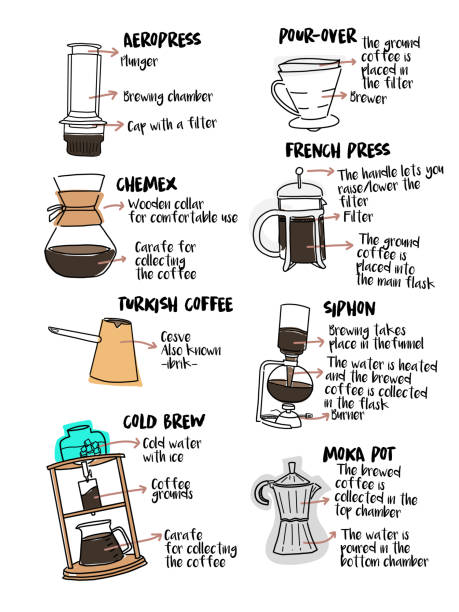A Comprehensive Overview to Numerous Coffee Brewing Methods You Need To Attempt
A Comprehensive Overview to Numerous Coffee Brewing Methods You Need To Attempt
Blog Article
The Scientific Research Behind Coffee Developing: Exactly How Temperature Level and Time Affect Your Drink
Understanding the scientific research behind coffee brewing discloses that temperature level and time are not simple variables yet essential elements that dictate the beverage's taste account and total quality. The ideal developing temperature usually falls in between 195 ° F and 205 ° F, while the duration of extraction differs significantly throughout different methods. This interplay of factors can result in a mug that is either frustrating or fascinating. As we check out the subtleties of these components, the inquiry arises: how can one efficiently equilibrium temperature level and time to accomplish that excellent mixture?
The Chemistry of Coffee Extraction
The chemistry of coffee extraction explores the elaborate processes that transform raw coffee beans right into the aromatic beverage delighted in worldwide. This makeover mostly involves the solubility of different substances existing in the beans, which are affected by aspects such as grind size, water top quality, and the developing approach utilized.
Throughout the developing procedure, hot water acts as a solvent, drawing out soluble substances, consisting of caffeine, sugars, acids, and lipids, from the coffee premises. Each compound adds to the taste account, scent, and body of the last drink. As an example, acids are accountable for appetizing and brilliant notes, while oils add to an abundant mouthfeel.
The extraction process is not consistent; various substances dissolve at different rates. The initial phases of brewing essence acids and sugars, resulting in a pleasant level of acidity, while prolonged extraction can cause resentment due to over-extraction of unfavorable substances. Recognizing these chemical interactions is essential for maximizing brewing strategies, as the equilibrium in between extraction time and water temperature level can dramatically influence the general quality of the coffee. Inevitably, understanding the chemistry of coffee extraction is key to achieving a all-round and flavorful mug.
Ideal Brewing Temperatures
Discovering the best brewing temperature is vital for opening the full potential of coffee tastes and scents - coffee brewing methods. Research shows that the optimum variety for brewing coffee exists between 195 ° F to 205 ° F(90 ° C to 96 ° C) Within this array, the extraction process properly liquifies the desirable soluble substances in coffee beans, resulting in a balanced and savory mug
Brewing at reduced temperatures, such as listed below 195 ° F(90 ° C ), may cause under-extraction, producing a weak and acidic mixture with muted tastes. Conversely, developing at temperatures exceeding 205 ° F(96 ° C) can bring about over-extraction, creating a harsh and bitter preference because of the too much dissolution of unfavorable compounds, such as tannins.
Additionally, the optimal brewing temperature level can vary depending on the coffee bean kind and roast level. Lighter roasts commonly benefit from slightly higher temperature levels to enhance their complicated taste profiles, while darker roasts might be much better suited to reduced temperatures to alleviate bitterness.
Inevitably, preserving accuracy in brewing temperatures is essential for achieving a harmonious balance of flavors, making sure that every mug of coffee supplies an enjoyable sensory experience.
Impact of Brewing Time
Developing time plays an essential function in identifying the flavor account and total high quality of coffee. Shorter developing times can result in under-extraction, helpful hints leading to a weak or sour flavor, as not adequate soluble compounds are dissolved.
Optimum developing time varies depending on the approach utilized and the grind dimension of the coffee. A French press typically requires about four minutes, while espresso extraction is typically completed within 25 to 30 secs. It is vital to calibrate developing time in combination with other variables, such as water temperature and coffee-to-water ratio, to achieve the preferred flavor profile.
Understanding the impact of developing time enables coffee fanatics to refine their developing techniques, ultimately enhancing the sensory experience of their cup (coffee brewing methods). With mindful focus to this variable, one can open the full potential of the coffee, exposing its unique features and subtleties
Brewing Approaches and Their Results

For instance, methods like French press and cool mixture enable a longer steeping time, causing a fuller body and durable flavor due to increased extraction of oils and soluble solids. On the other hand, espresso developing uses high stress and a shorter removal time, generating a concentrated shot that emphasizes intense flavors and a rich crema.
Pour-over techniques, such as Chemex or V60, provide a more controlled extraction process, allowing the maker to manipulate flow rate and water distribution, which can enhance brightness and clarity. Meanwhile, percolation methods cycle water with the coffee premises numerous times, from this source bring about a stronger, often bitter flavor.
Lastly, making use of paper filters versus metal filters can also affect the final taste; paper filters typically generate a cleaner cup by trapping oils and fine bits, while metal filters enable more oils to pass through, adding to a fuller mouthfeel - coffee brewing methods. Recognizing these subtleties can boost the coffee experience substantially
Tips for Improving Your Mixture
A well-executed mixture Full Article can change also the most basic coffee right into a remarkable experience. To achieve this, focus to information is essential. Begin with top notch, fresh baked beans, as their flavor account diminishes gradually. Grind the beans right before making to maximize quality, ensuring the grind size matches your developing technique-- coarser for French press and finer for espresso.
Water top quality plays a critical function; usage filtered water devoid of impurities. The excellent brewing temperature level ranges between 195 ° F and 205 ° F(90 ° C to 96 ° C ) Also hot can scorch the coffee, while as well amazing might under-extract flavors.
Timing is just as essential. For immersion approaches, steeping for 3 to five mins is ideal, whereas drip methods typically take about five minutes. Trying out brew times to find your recommended stamina.

Verdict
In recap, the elaborate partnership in between temperature and time is critical in the coffee developing procedure. Abiding by optimum developing temperatures in between 195 ° F and 205 ° F, along with precise timing tailored to every approach, guarantees the wanted flavor account is attained. Understanding these scientific principles encourages individuals to refine their developing techniques, eventually resulting in a more pleasurable and balanced coffee experience. Proficiency of these aspects is vital for any type of coffee lover seeking excellence in their beverage.
Recognizing the scientific research behind coffee brewing discloses that temperature level and time are not simple variables but critical components that determine the drink's flavor account and total high quality. Understanding these chemical interactions is essential for optimizing developing strategies, as the balance in between removal time and water temperature can significantly affect the overall top quality of the coffee.Brewing time plays an essential role in establishing the flavor profile and general quality of coffee. By concentrating on these components-- bean top quality, grind dimension, water temperature, steeping time, and proportion-- you can raise your coffee developing procedure, resulting in a regularly premium cup.
In recap, the detailed relationship between temperature level and time is critical in the coffee developing procedure.
Report this page